forecast
Forecast sample paths from threshold-switching dynamic regression model
Since R2021b
Syntax
Description
YF = forecast(Mdl,Y,numPeriods)YF of a fully specified
threshold-switching dynamic regression model Mdl over a forecast
horizon of length numPeriods. The forecasted responses represent the
continuation of the response data Y.
YF = forecast(Mdl,Y,numPeriods,Name,Value)forecast(Mdl,Y,10,Type="exogenous",Z=z)
specifies exogenous-type forecasts and forecast-period, exogenous threshold variable data
z.
Examples
This example shows how to compute iterative point forecasts of the conditional mean of a self-exciting threshold autoregressive (SETAR) model. Specify all parameter values (this example uses arbitrary values).
Create Fully Specified Model for DGP
Create a discrete threshold transition at level 0.
t = 0; tt = threshold(t)
tt =
threshold with properties:
Type: 'discrete'
Levels: 0
Rates: []
StateNames: ["1" "2"]
NumStates: 2
tt is a fully specified threshold object that describes the switching mechanism of the threshold-switching model.
Assume the following univariate models describe the response process of the system:
State 1: .
State 2: .
.
For each regime, use arima to create an AR model that describes the response process within the regime.
c1 = -1; c2 = 1; ar = 0.6; mdl1 = arima(Constant=c1,AR=ar)
mdl1 =
arima with properties:
Description: "ARIMA(1,0,0) Model (Gaussian Distribution)"
SeriesName: "Y"
Distribution: Name = "Gaussian"
P: 1
D: 0
Q: 0
Constant: -1
AR: {0.6} at lag [1]
SAR: {}
MA: {}
SMA: {}
Seasonality: 0
Beta: [1×0]
Variance: NaN
mdl2 = arima(Constant=c2,AR=ar)
mdl2 =
arima with properties:
Description: "ARIMA(1,0,0) Model (Gaussian Distribution)"
SeriesName: "Y"
Distribution: Name = "Gaussian"
P: 1
D: 0
Q: 0
Constant: 1
AR: {0.6} at lag [1]
SAR: {}
MA: {}
SMA: {}
Seasonality: 0
Beta: [1×0]
Variance: NaN
mdl1 and mdl2 are effectively, fully specified arima objects. The innovations variances of the submodels are unspecified; the tsVAR object specifies the model-wide innovations variance.
Store the submodels in a vector with order corresponding to the regimes in tt.StateNames.
mdl = [mdl1; mdl2];
Use tsVAR to create a TAR model from the switching mechanism tt and the state-specific submodels mdl. Specify a model-wide innovations variance of 0.5.
Mdl = tsVAR(tt,mdl,Covariance=0.5)
Mdl =
tsVAR with properties:
Switch: [1×1 threshold]
Submodels: [2×1 varm]
NumStates: 2
NumSeries: 1
StateNames: ["1" "2"]
SeriesNames: "1"
Covariance: 0.5000
Mdl.Submodels(2)
ans =
varm with properties:
Description: "AR-Stationary 1-Dimensional VAR(1) Model"
SeriesNames: "Y1"
NumSeries: 1
P: 1
Constant: 1
AR: {0.6} at lag [1]
Trend: 0
Beta: [1×0 matrix]
Covariance: NaN
Mdl is a fully specified tsVAR object representing a univariate two-state TAR model. tsVAR stores specified arima submodels as varm objects.
Simulate Response Data from DGP
forecast requires enough data before the forecast horizon to initialize the model. Simulate 120 observations from the DGP.
rng(1); % For reproducibility
y = simulate(Mdl,120);y is a 120-by-1 random path of responses. The default options of simulate, and all tsVAR object functions, specify that the threshold variable is .
Compute Optimal Point Forecasts
Treat the first 100 observations of the simulated response data as the presample for the forecast, and treat the last 10 observations as a holdout sample.
idx0 = 1:100; idx1 = 101:120; y0 = y(idx0); y1 = y(idx1);
Compute 1- through 20-step-ahead optimal point forecasts from the model.
yf = forecast(Mdl,y0,20);
yf is a 20-by-1 vector of optimal point forecasts.
Plot the simulated response data and forecasts.
figure hold on plot(idx0,y0,'b'); h = plot(idx1,y1,'b--'); h1 = plot(idx1,yf,'r'); yfill = [ylim fliplr(ylim)]; xfill = [idx0(end) idx0(end) idx1(end) idx1(end)]; fill(xfill,yfill,'k','FaceAlpha',0.05) legend([h h1],["Actual" "Optimal"],'Location','NorthWest') title('Forecasts') hold off

forecast must use Monte Carlo methods to estimate forecast error variances. Therefore, when simulate returns forecast error variances, it uses Monte Carlo methods to compute point forecasts.
Create the SETAR model in Compute Optimal Point Forecasts.
t = 0; tt = threshold(t); c1 = -1; c2 = 1; ar = 0.6; mdl1 = arima(Constant=c1,AR=ar); mdl2 = arima(Constant=c2,AR=ar); mdl = [mdl1; mdl2]; Mdl = tsVAR(tt,mdl,Covariance=0.5);
forecast requires enough data before the forecast horizon to initialize the model. Simulate 120 observations from the DGP.
rng(100); % For reproducibility
fh = 20;
y = simulate(Mdl,100+fh);Treat the first 100 observations of the simulated response data as the presample for the forecast, and treat the last 20 observations as a holdout sample.
idx0 = 1:100; idx1 = 101:(100 + fh); y0 = y(idx0); y1 = y(idx1);
Compute 1- through 20-step-ahead optimal point forecasts from the model.
yf1 = forecast(Mdl,y0,fh);
yf1 is a 20-by-1 vector of optimal point forecasts.
Compute 1- through 20-step-ahead Monte Carlo point forecasts by returning the estimated forecast error variances.
[yf2,estVar] = forecast(Mdl,y0,fh);
yf2 is a 20-by-1 vector of Monte Carlo point forecasts. estVAR is a 20-by-1 vector of corresponding estimated forecast error variances.
Plot the simulated response data, forecasts, and 95% forecast intervals using the Monte Carlo estimates.
figure hold on plot(idx0,y0,'b'); h = plot(idx1,y1,'b--'); h1 = plot(idx1,yf1,'r'); h2 = plot(idx1,yf2,'m'); ciu = yf2 + 1.96*sqrt(estVar); % Upper 95% confidence level cil = yf2 - 1.96*sqrt(estVar); % Lower 95% confidence level plot(idx1,ciu,'m-.'); plot(idx1,cil,'m-.'); yfill = [ylim,fliplr(ylim)]; xfill = [idx0(end) idx0(end) idx1(end) idx1(end)]; fill(xfill,yfill,'k','FaceAlpha',0.05) legend([h h1 h2],["Actual" "Optimal" "Estimated"],... 'Location',"NorthWest") title("Point and Interval Forecasts") hold off
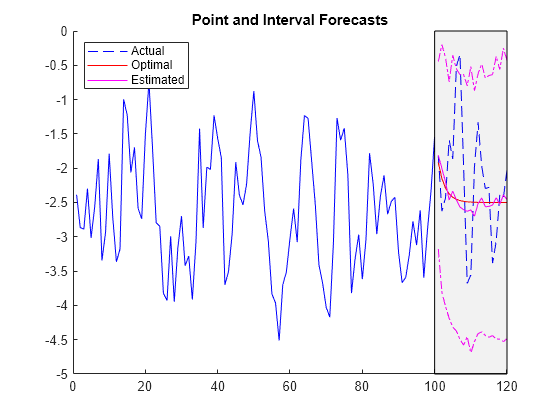
When forecast performs Monte Carlo methods to estimate point forecasts and forecast error covariances, you can adjust the number of paths to sample by specifying the NumPaths option.
Create the SETAR model in Compute Optimal Point Forecasts.
t = 0; tt = threshold(t); c1 = -1; c2 = 1; ar = 0.6; mdl1 = arima(Constant=c1,AR=ar); mdl2 = arima(Constant=c2,AR=ar); mdl = [mdl1; mdl2]; Mdl = tsVAR(tt,mdl,Covariance=0.5);
forecast requires enough data before the forecast horizon to initialize the model. Simulate 120 observations from the DGP.
rng(100); % For reproducibility
fh = 20;
y = simulate(Mdl,100+fh);Treat the first 100 observations of the simulated response data as the presample for the forecast, and treat the last 20 observations as a holdout sample.
idx0 = 1:100; idx1 = 101:(100 + fh); y0 = y(idx0); y1 = y(idx1);
Compute 1- through 20-step-ahead optimal point forecasts from the model.
yf1 = forecast(Mdl,y0,fh);
Compute 1- through 20-step-ahead Monte Carlo point forecasts by returning the estimated forecast error variances. Specify a Monte Carlo sample of 1000 paths.
[yf2,estVar] = forecast(Mdl,y0,fh,NumPaths=1000);
yf2 is a 20-by-1 vector of Monte Carlo point forecasts. estVAR is a 20-by-1 vector of corresponding estimated forecast error variances.
Plot the simulated response data, forecasts, and 95% forecast intervals using the Monte Carlo estimates.
figure hold on plot(idx0,y0,'b'); h = plot(idx1,y1,'b--'); h1 = plot(idx1,yf1,'r'); h2 = plot(idx1,yf2,'m'); ciu = yf2 + 1.96*sqrt(estVar); % Upper 95% confidence level cil = yf2 - 1.96*sqrt(estVar); % Lower 95% confidence level plot(idx1,ciu,'m-.'); plot(idx1,cil,'m-.'); yfill = [ylim,fliplr(ylim)]; xfill = [idx0(end) idx0(end) idx1(end) idx1(end)]; fill(xfill,yfill,'k',FaceAlpha=0.05) legend([h h1 h2],["Actual" "Optimal" "Estimated"],Location="NorthWest") title("Point and Interval Forecasts") hold off
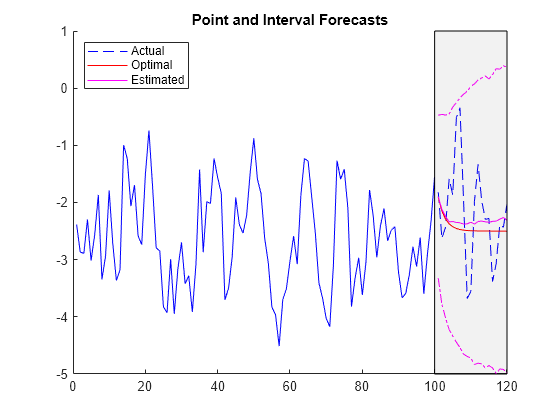
Consider a logistic threshold-switching model (LSTAR) for the real US GDP growth rate, where each submodel is AR(4) and the threshold variable is the unemployment growth rate.
Create a partially specified threshold transition for the unemployment growth rate. Specify the logistic transition function, and an unknown, estimable mid-level and rate. Label the states "Contraction" and "Expansion".
tt = threshold(NaN,Type="logistic",Rates=NaN,... StateNames=["Contraction" "Expansion"]);
tt is a partially specified threshold object, and it is agnostic of the variable and data it represents.
Create a threshold-switching model for the real US GDP growth rate.
p = 4; mdl = [arima(ARLags=p); arima(ARLags=p)]; Mdl = tsVAR(tt,mdl);
Mdl is a partially specified tsVAR object specifying the structure of the model and which parameters are estimable.
Load the quarterly US macroeconomic data set Data_USEconModel. Remove leading missing values in the series. Compute the real GDP percent growth and unemployment growth.
load Data_USEconModel DataTimeTable = rmmissing(DataTimeTable,DataVariables=["GDP" "GDPDEF" "UNRATE"]); RGDP = DataTimeTable.GDP./DataTimeTable.GDPDEF; rRGDP = price2ret(RGDP); % Response data gUNRATE = diff(DataTimeTable.UNRATE); % Exogenous thresold data dts = DataTimeTable.Time(2:end); T = numel(dts);
Hold out the following sets from estimation:
The first four observations as a presample for estimation.
The final 25% as a forecast horizon to compare with the forecasts.
fh = ceil(0.25*T); idxPre = 1:p; idxEst = (idxPre(end)+1):(T-fh); idxF = (T-fh+1):T;
To initialize the estimation procedure, fully specify a threshold transition that has the same structure as tt, but set the mid-level to 0 and a rate of 1 (the default).
tt0 = threshold(0,Type=tt.Type);
Fit the LSTAR model to the estimation period of the US GDP growth rate series. Specify the following parameters:
Set
Y0to the responses before the estimation period to initialize the AR submodel components.Set
Typeto"exogenous"to characterize the threshold variable.Set
Zto the threshold variable datagUNRATEin the estimation period.
EstMdl = estimate(Mdl,tt0,rRGDP(idxEst),Y0=rRGDP(idxPre), ... Type="exogenous",Z=gUNRATE(idxEst));
Forecast the real GDP growth rate series into the forecast horizon. Initialize the forecasts by specifying all responses in the estimation period (forecast uses only the latest, required observations). Characterize the threshold variable and provide its data in the forecast horizon.
yF = forecast(EstMdl,rRGDP(idxEst),fh,Type="exogenous",Z=gUNRATE(idxF));Plot the real GDP growth rate series with the forecasts.
figure hold on h1 = plot(dts(idxEst),rRGDP(idxEst),'b'); h2 = plot(dts(idxF),rRGDP(idxF),'b--'); h3 = plot(dts(idxF),yF,'r'); yfill = [ylim,fliplr(ylim)]; xfill = dts([idxEst(end) idxEst(end) idxF(end) idxF(end)]); fill(xfill,yfill,'k',FaceAlpha=0.05) legend([h1 h2 h3],["Data (estimation)" "Data (hold out)" "Forecasts"],... Location="NorthWest") title("Real GDP Growth Rate Point Forecasts") hold off

Consider the following 2-D LSETAR model.
State 1,
"Low": whereState 2 ,
"Med": whereState 3,
"High": whereThe system is in state 1 when , the system is in state 2 when , and the system is in state 3 otherwise.
The transition function is logistic. The transition rate from state 1 to 2 is 3.5, and the transition rate from state 1 to 3 is 1.5.
Create logistic threshold transitions at mid-levels -1 and 1 with rates 3.5 and 1.5, respectively. Label the states.
t = [-1 1]; r = [3.5 1.5]; stateNames = ["Low" "Med" "High"]; tt = threshold(t,Type="logistic",Rates=[3.5 1.5],StateNames=stateNames);
Create the VAR submodels by using varm. Store the submodels in a vector with order corresponding to the regimes in tt.StateNames.
% Constants (numSeries x 1 vectors) C1 = [1; -1]; C2 = [2; -2]; C3 = [3; -3]; % Autoregression coefficients (numSeries x numSeries matrices) AR1 = {}; % 0 lags AR2 = {[0.5 0.1; 0.5 0.5]}; % 1 lag AR3 = {[0.25 0; 0 0] [0 0; 0.25 0]}; % 2 lags % Innovations covariances (numSeries x numSeries matrices) Sigma1 = [1 -0.1; -0.1 1]; Sigma2 = [2 -0.2; -0.2 2]; Sigma3 = [3 -0.3; -0.3 3]; % VAR Submodels mdl1 = varm('Constant',C1,'AR',AR1,'Covariance',Sigma1); mdl2 = varm('Constant',C2,'AR',AR2,'Covariance',Sigma2); mdl3 = varm('Constant',C3,'AR',AR3,'Covariance',Sigma3); mdl = [mdl1; mdl2; mdl3];
Create an LSETAR model from the switching mechanism tt and the state-specific submodels mdl. Label the series Y1 and Y2.
Mdl = tsVAR(tt,mdl,SeriesNames=["Y1" "Y2"])
Mdl =
tsVAR with properties:
Switch: [1×1 threshold]
Submodels: [3×1 varm]
NumStates: 3
NumSeries: 2
StateNames: ["Low" "Med" "High"]
SeriesNames: ["Y1" "Y2"]
Covariance: []
Mdl is a fully specified tsVAR object representing a multivariate three-state LSETAR model. tsVAR object functions enable you to specify threshold variable characteristics and data.
Simulate Responses for Forecast Presample
You must specify enough presample observations to initialize all AR components in the VAR models and the endogenous threshold variable. The largest AR component order is 2 and the threshold variable delay is 4. Therefore, simulate and forecast require four presample observations per series and path.
Simulate one 2-D path of 100 observations from the model. Specify the endogenous threshold variable and its delay, .
rng(1) % For reproducibility
numObs = 100;
Y0F = simulate(Mdl,numObs,Delay=4,Index=2);Y0F is a 100-by-2 matrix representing one random path simulated from Mdl.
Forecast Responses
Forecast the LSETAR model into a 50-period horizon. Specify the endogenous threshold variable and its delay.
fh = 50; YF = forecast(Mdl,Y0F,fh,Index=2,Delay=4);
Y is a 20-by-2 matrix of 20 stepwise forecasted responses from Mdl.
Plot the simulated path and forecasts for each variable on separate plots.
tiledlayout(2,1) nexttile plot(1:100,Y0F(:,1),"b",101:(100+fh),YF(:,1),"r--") title("Y1") legend(["Presample" "Forecasts"]) nexttile plot(1:100,Y0F(:,2),"b",101:(100+fh),YF(:,2),"r--") legend(["Presample" "Forecasts"]) title("Y2")
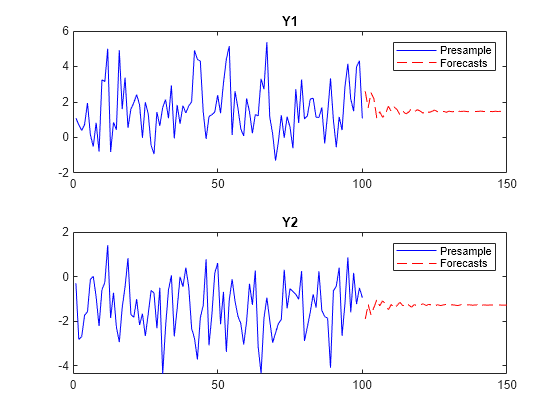
Consider including regression components for exogenous variables in each submodel of the threshold-switching dynamic regression model in Forecast Multivariate LSETAR Model.
Fully Specify LSETAR Model
Create logistic threshold transitions at mid-levels -1 and 1, with rates 3.5 and 1.5, respectively. Label the states.
t = [-1 1]; r = [3.5 1.5]; stateNames = ["Low" "Med" "High"]; tt = threshold(t,Type="logistic",Rates=[3.5 1.5],StateNames=stateNames)
tt =
threshold with properties:
Type: 'logistic'
Levels: [-1 1]
Rates: [3.5000 1.5000]
StateNames: ["Low" "Med" "High"]
NumStates: 3
Assume the following VARX models describe the response processes of the system:
State 1: where
State 2: where
State 3: where
represents a single exogenous variable, represents two exogenous variables, and represents three exogenous variables. Store the submodels in a vector.
% Constants (numSeries x 1 vectors) C1 = [1; -1]; C2 = [2; -2]; C3 = [3; -3]; % Regression coefficients (numSeries x numRegressors matrices) Beta1 = [1; -1]; % 1 regressor Beta2 = [2 2; -2 -2]; % 2 regressors Beta3 = [3 3 3; -3 -3 -3]; % 3 regressors % Autoregression coefficients (numSeries x numSeries matrices) AR1 = {}; AR2 = {[0.5 0.1; 0.5 0.5]}; AR3 = {[0.25 0; 0 0] [0 0; 0.25 0]}; % Innovations covariances (numSeries x numSeries matrices) Sigma1 = [1 -0.1; -0.1 1]; Sigma2 = [2 -0.2; -0.2 2]; Sigma3 = [3 -0.3; -0.3 3]; % VARX submodels mdl1 = varm(Constant=C1,AR=AR1,Beta=Beta1,Covariance=Sigma1); mdl2 = varm(Constant=C2,AR=AR2,Beta=Beta2,Covariance=Sigma2); mdl3 = varm(Constant=C3,AR=AR3,Beta=Beta3,Covariance=Sigma3); mdl = [mdl1; mdl2; mdl3];
Create an LSETAR model from the switching mechanism tt and the state-specific submodels mdl. Label the series Y1 and Y2.
Mdl = tsVAR(tt,mdl,SeriesNames=["Y1" "Y2"]);
Forecast Responses Ignoring Regression Component
If you do not supply exogenous data, forecast ignores the regression components in the submodels.
Obtain a presample, from which to forecast, by simulating one 2-D path of 100 observations from the model. Specify the endogenous threshold variable and its delay, .
rng(1) % For reproducibility
numObs = 100;
Y0F = simulate(Mdl,numObs,Delay=4,Index=2);Forecast the LSETAR model into a 50-period horizon. Specify the endogenous threshold variable and its delay.
fh = 50; YF = forecast(Mdl,Y0F,fh,Index=2,Delay=4);
Plot the simulated path and forecasts for each variable on separate plots.
figure; plot(1:numObs,Y0F(:,1),"b",(numObs+1):(numObs+fh),YF(:,1),"r--") title("Y1") legend(["Presample" "Forecasts"]) nexttile
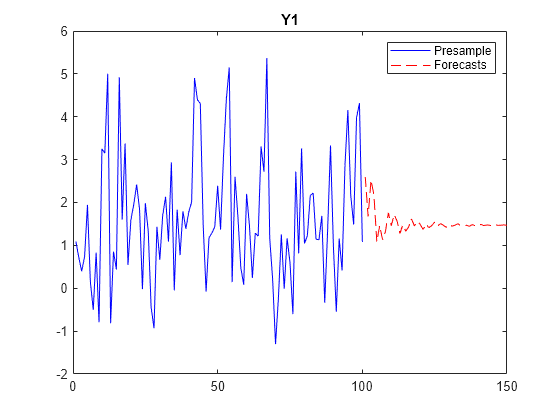
plot(1:numObs,Y0F(:,2),"b",(numObs+1):(numObs+fh),YF(:,2),"r--") legend(["Presample" "Forecasts"]) title("Y2")
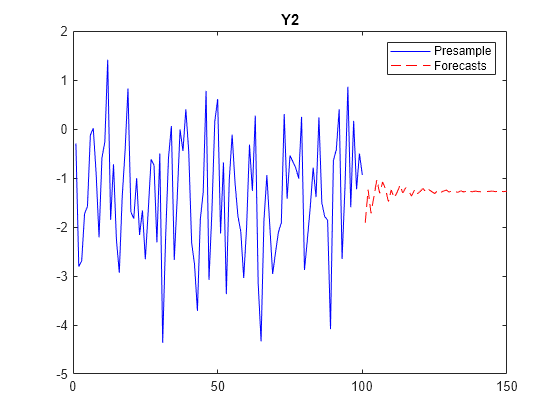
Simulate Data Including Regression Component
To generate random paths from the model, forecast requires expgenous data.
Assume the following AR models for the regressors:
, where .
, where .
, where .
MdlX1 = arima(Constant=1,AR={0.1},Variance=1);
MdlX2 = arima(Constant=2,AR={0 0.2},Variance=2);
MdlX3 = arima(Constant=3,AR={0 0 0.3},Variance=3);Simulate 100 observations from each model to represent in-sample data for the exogenous predictors.
X10F = simulate(MdlX1,numObs); X20F = simulate(MdlX2,numObs); X30F = simulate(MdlX3,numObs); X0F = [X10F X20F X30F];
Forecast 50 observations from each model to represent exogenous data in the forecast horizon. Specify the simulated in-sample data as a presample.
X1F = forecast(MdlX1,numObs,Y0=X10F); X2F = forecast(MdlX2,numObs,Y0=X20F); X3F = forecast(MdlX3,numObs,Y0=X30F); XF = [X1F X2F X3F];
Obtain presample response data, from which to forecast, by simulating one 2-D path of 100 observations from the model. Specify the endogenous threshold variable and its delay, and specify the simulated exogenous data.
Y0FX = simulate(Mdl,numObs,Delay=4,Index=2,X=X0F);
Forecast the LSETAR model into a 50-period horizon. Specify the endogenous threshold variable and its delay, and specify the exogenous data in the forecast horizon.
YFX = forecast(Mdl,Y0FX,fh,Index=2,Delay=4,X=XF); figure; plot(1:numObs,Y0FX(:,1),"b",(numObs+1):(numObs+fh),YFX(:,1),"r--") title("Y1") legend(["Presample" "Forecasts"]) nexttile
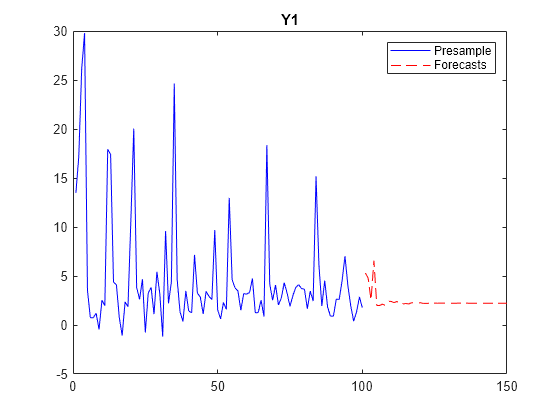
plot(1:numObs,Y0FX(:,2),"b",(numObs+1):(numObs+fh),YFX(:,2),"r--") legend(["Presample" "Forecasts"]) title("Y2")
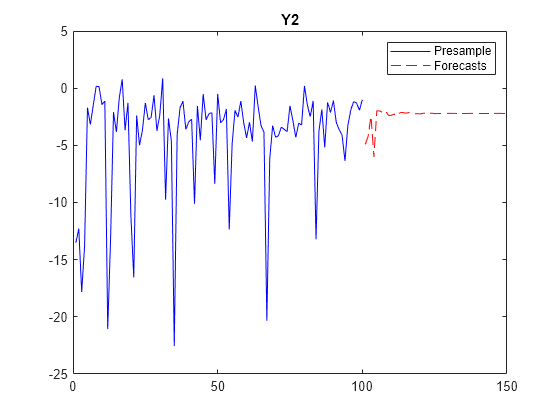
Input Arguments
Response data that provides initial values for the forecasts, specified as a
numObs-by-numSeries numeric matrix.
numObs is the sample size. numSeries is the
number of response variables (Mdl.NumSeries).
Rows correspond to observations, and the last row contains the latest observation. Columns correspond to individual response variables.
Y must contain enough observations to initialize AR terms of all
submodels. For self-exciting models, Y must also contain enough
observations to initialize the delayed response
yj,t−d.
The forecasts YF represent the continuation of
Y.
Data Types: double
Forecast horizon, or the number of time points in the forecast period, specified as a positive integer.
Data Types: double
Name-Value Arguments
Specify optional pairs of arguments as
Name1=Value1,...,NameN=ValueN, where Name is
the argument name and Value is the corresponding value.
Name-value arguments must appear after other arguments, but the order of the
pairs does not matter.
Before R2021a, use commas to separate each name and value, and enclose
Name in quotes.
Example: 'X',X uses the matrix X as exogenous data
in the forecast horizon to evaluate regression components in the model.
Type of threshold variable data, specified as a value in this table.
| Value | Description |
|---|---|
"endogenous" | The model is self-exciting with threshold variable data generated by response j, where
|
"exogenous" | The threshold variable is exogenous to the system. The name-value argument 'Z' specifies the threshold variable data and is required. |
Example: Type="exogenous",Z=z specifies the data z for the exogenous threshold variable.
Example: Type="endogenous",Index=2,Delay=4 specifies the endogenous threshold variable as y2,t−4, whose data is Y(:,2).
Data Types: char | string | cell
Threshold variable data in the forecast horizon, for forecasts of type
"exogenous", specified as a numeric vector of length
numPeriods.
Data Types: double
Threshold variable delay d in
yj,t−d,
for forecasts of type "endogenous", specified as a positive
integer.
Example: Delay=4 specifies that the threshold variable is
y2,t−d,
where j is the value of Index.
Data Types: double
Threshold variable index j in
yj,t−d,
for forecasts of type "endogenous", specified as a scalar in
1:Mdl.NumSeries.
forecast ignores Index for univariate
AR models.
Example: Index=2 specifies that the threshold variable is
y2,t−d,
where d is the value of Delay.
Data Types: double
Predictor data in the forecast horizon used to evaluate regression components in
all submodels of Mdl, specified as a numeric matrix or a cell
vector of numeric matrices. The first row of X contains
observations in the period after the period represented by the last observation in
Y.
To use a subset of the same predictors in each state, specify X
as a matrix with numPreds columns and at least
numPeriods rows. Columns correspond to distinct predictor
variables. Submodels use initial columns of the associated matrix, in order, up to the
number of submodel predictors. The number of columns in the Beta
property of Mdl.SubModels( determines
the number of exogenous variables in the regression component of submodel
j)jnumPeriods, then forecast uses the
earliest observations.
To use different predictors in each state, specify a cell vector of such matrices
with length numStates.
By default, forecast ignores the regression components in
Mdl.
Data Types: double
Number of sample paths to generate for the simulation, specified as a positive
integer. If forecast returns only YF, it
ignores NumPaths.
Example: NumPaths=1000
Data Types: double
Output Arguments
Point forecasts, returned as a
numPeriods-by-numSeries numeric matrix.
If forecast returns only YF, represents
stepwise-optimal forecasts. Otherwise, forecast uses Monte Carlo
simulation to estimate YF.
Forecast error covariances, returned as a numeric column vector or numeric array.
If the submodels Mdl.SubModels represent univariate ARX models, EstCov is a numPeriods-by-1 vector. If Mdl.SubModels represent multivariate VARX models, EstCov is a numSeries-by-numSeries-by-numPeriods array.
forecast performs Monte Carlo simulation to compute EstCov.
Tips
References
[1] Brown, Bryan W., and Roberto S. Mariano. "Predictors in Dynamic Nonlinear Models: Large-Sample Behavior." Econometric Theory, 5 (December 1989): 430–52. https://doi.org/10.1017/S0266466600012603.
[2] Clements, Michael P., and Jeremy Smith. "The Performance of Alternative Forecasting Methods for SETAR Models." International Journal of Forecasting, 13 (December 1997): 463–75. https://doi.org/10.1016/S0169-2070(97)00017-4.
[3] Hyndman, Rob J. "Highest-Density Forecast Regions for Nonlinear and Non-Normal Time Series Models." Journal of Forecasting, 14 (September 1995): 431–41. https://doi.org/10.1002/for.3980140503.
[4] Lin, Jin-Lung, and Clive W. J. Granger. "Forecasting from Non-Linear Models in Practice." Journal of Forecasting, 3 (January 1994): 1–9. https://doi.org/10.1002/for.3980130102.
[5] Teräsvirta, Tima. "Modelling Economic Relationships with Smooth Transition Regressions." In A. Ullahand and D.E.A. Giles (eds.), Handbook of Applied Economic Statistics, 507–552. New York: Marcel Dekker, 1998.
[6] van Dijk, Dick. Smooth Transition Models: Extensions and Outlier Robust Inference. Rotterdam, Netherlands: Tinbergen Institute Research Series, 1999.
Version History
Introduced in R2021b
MATLAB Command
You clicked a link that corresponds to this MATLAB command:
Run the command by entering it in the MATLAB Command Window. Web browsers do not support MATLAB commands.
Seleccione un país/idioma
Seleccione un país/idioma para obtener contenido traducido, si está disponible, y ver eventos y ofertas de productos y servicios locales. Según su ubicación geográfica, recomendamos que seleccione: .
También puede seleccionar uno de estos países/idiomas:
Cómo obtener el mejor rendimiento
Seleccione China (en idioma chino o inglés) para obtener el mejor rendimiento. Los sitios web de otros países no están optimizados para ser accedidos desde su ubicación geográfica.
América
- América Latina (Español)
- Canada (English)
- United States (English)
Europa
- Belgium (English)
- Denmark (English)
- Deutschland (Deutsch)
- España (Español)
- Finland (English)
- France (Français)
- Ireland (English)
- Italia (Italiano)
- Luxembourg (English)
- Netherlands (English)
- Norway (English)
- Österreich (Deutsch)
- Portugal (English)
- Sweden (English)
- Switzerland
- United Kingdom (English)